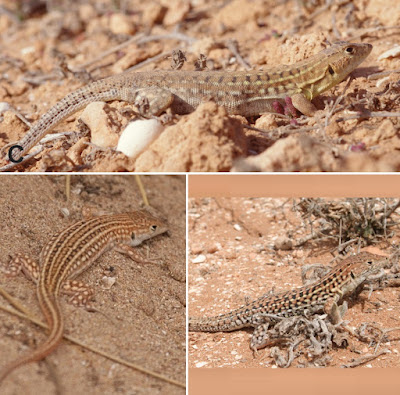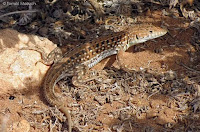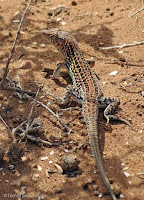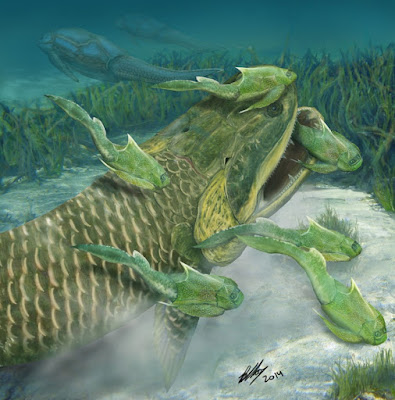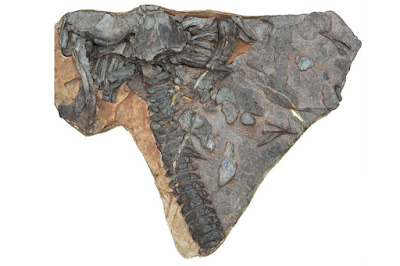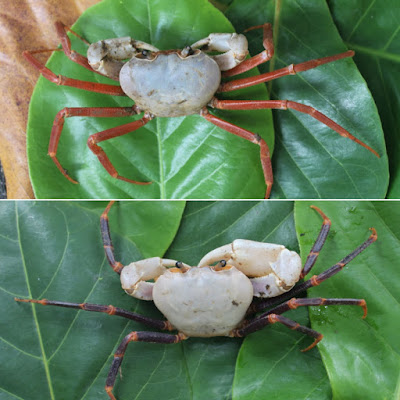[Most Recent Entries] [Calendar View]
Tuesday, September 5th, 2017
| Time | Event | ||||
| 5:58a | [Herpetology • 2017] Acanthodactylus margaritae • Systematic Revision of Acanthodactylus busacki (Squamata: Lacertidae) with A Description of A New Species from Morocco
Abstract Recent molecular phylogenies of the Acanthodactylus pardalis species-group have revealed a deep genetic divergence within the nominal species A. busacki from north-west Africa. The species is phylogenetically separated into northern and southern lineages, which correspond to a previously observed morphological differentiation between the northern and southern populations of this species. Based on morphological comparisons of the type material and location of the type locality, the nomen Acanthodactylus busacki Salvador, 1982 is assigned here to the southern lineage, known from the northern Saharan Atlantic coastal desert. The northern lineage, described here as Acanthodactylus margaritae sp. nov., is prominently characterized by weakly keeled dorsal scales and a characteristic colour pattern. The new species is endemic to Morocco and confined to arid and semi-arid bioclimatic areas between the High Atlas and Anti-Atlas Mountains, from around Tamri in the north to Tiznit in the south and the Souss valley in the east. Keywords: Reptilia, Atlas Mountains, evolution, lizards, pardalis species-group, phylogeny, taxonomy Acanthodactylus margaritae sp. nov. Chresonyms: Acanthodactylus busacki Salvador, 1982: 88 (part.) Acanthodactylus pardalis Bedriagai Arnold, 1983: 319 (part.) Acanthodactylus bedriagai Harris & Arnold 2000: 352 (part.) Acanthodactylus busacki Mellado & Dakki 1988: 175 (part.); Mellado & Olmedo 1990: 133 (part.); Bons & Geniez 1996: 162 (part.); Schleich et al. 1996: 391 (part.); Geniez et al. 2004: 102 (part.); Brito et al. 2008: 21 (part.); Sindaco & Jeremčenko 2008: 218 (part.); Fonseca et al. 2008: 9 (part.); Harris el al. 2010: 22 (part.); Barata et al. 2011: 7 (part.); Carretero et al. 2011: 139 (part.); Trape et al. 2012: 302 (part.); Pyron et al. 2013: 17 (part.); Tamar et al. 2016: 8 (part.) Etymology. The specific epithet “ margaritae ”, a noun in the genitive case, honours Dr Margarita Metallinou who tragically lost her life during field-work in Africa in July 2015. The new species is dedicated to Margarita Metallinou from all the authors in recognition of her passion, interest and strong contribution to the study of reptile systematics (especially of geckoes of the genera Stenodactylus and Ptyodactylus) and to her friendship over the years. Distribution. Acanthodactylus margaritae sp. nov. is endemic to Morocco, .... Its range is limited by the High Atlas and Anti-Atlas Mountains to the north, east and south, and is entirely included in the arid and semi-arid climates with warm or temperate winters (Bons & Geniez 1996). Natural history. Acanthodactylus margaritae sp. nov. is a ground-dwelling, diurnal, oviparous, medium-sized lizard, relatively large and stout-bodied. It mostly inhabits stony plains with fine grained soils, stable sands and fixed dunes, or hard clay grounds with scarce low vegetation but also, especially in the Souss valley, open argan tree forests. It is often sympatric with Acanthodactylus aureus in the coastal area, though the latter species prefers softer, looser sands. Karin Tamar, Philippe Geniez, José C. Brito and Pierre-André Crochet. 2017. Systematic Revision of Acanthodactylus busacki (Squamata: Lacertidae) with A Description of A New Species from Morocco. Zootaxa. 4276(3); 357-386. DOI: 10.11646/zootaxa.4276.3.3 | ||||
| 6:03a | [PaleoIchthyology • 2017] Hongyu chowi • A Devonian Tetrapod-like Fish Reveals Substantial Parallelism in Stem Tetrapod Evolution
Abstract The fossils assigned to the tetrapod stem group document the evolution of terrestrial vertebrates from lobe-finned fishes. During the past 18 years the phylogenetic structure of this stem group has remained remarkably stable, even when accommodating new discoveries such as the earliest known stem tetrapod Tungsenia and the elpistostegid (fish–tetrapod intermediate) Tiktaalik. Here we present a large lobe-finned fish from the Late Devonian period of China that disrupts this stability. It combines characteristics of rhizodont fishes (supposedly a basal branch in the stem group, distant from tetrapods) with derived elpistostegid-like and tetrapod-like characters. This mélange of characters may reflect either detailed convergence between rhizodonts and elpistostegids plus tetrapods, under a phylogenetic scenario deduced from Bayesian inference analysis, or a previously unrecognized close relationship between these groups, as supported by maximum parsimony analysis. In either case, the overall result reveals a substantial increase in homoplasy in the tetrapod stem group. It also suggests that ecological diversity and biogeographical provinciality in the tetrapod stem group have been underestimated.
Systematic palaeontology. Osteichthyes Huxley, 1880 Sarcopterygii Romer, 1955 Tetrapodomorpha Ahlberg, 1991 Hongyu chowi gen. et sp. nov. Etymology. The generic name derives from hong (Chinese Pinyin), which means large and yu (Chinese Pinyin), which means fish. The specific is in honor of Min-Chen Chow. Holotype. IVPP V17681, a three-dimensionally preserved and partially articulated specimen. Locality. A quarry at Shixiagou, Qingtongxia, Ningxia, China. Approximate coordinates: 37° 39′ 18.4″ N, 105° 59′ 34.2″ E. Horizon. Zhongning Formation, Famennian, Late Devonian period. Min Zhu, Per E. Ahlberg, Wen-Jin Zhao and Lian-Tao Jia. 2017. A Devonian Tetrapod-like Fish Reveals Substantial Parallelism in Stem Tetrapod Evolution. Nature Ecology & Evolution. DOI: 10.1038/s41559-017-0293-5Weird fish fossil changes the story of how we moved onto land | ||||
| 9:09a | [Crustacea • 2017] Tiwaripotamon hamyen & T. xuanson • Two New Species of Freshwater Crabs of the Genus Tiwaripotamon Bott, 1970 (Decapoda, Brachyura, Potamidae) from northern Vietnam
Abstract Two new terrestrial crab species of the family Potamidae, Tiwaripotamon xuanson and T. hamyen, are described from northern Vietnam. Tiwaripotamon xuanson was collected from Xuan Son National Park, Thanh Son district, Phu Tho province, and T. hamyen was found in Binh Xa commune, Ham Yen district, Tuyen Quang province. They can be distinguished from other congeners by distinct carapace characteristics and gonopod 1 structures. Key words. Tiwaripotamon xuanson, Tiwaripotamon hamyen, taxonomy
TAXONOMY Family Potamidae Ortmann, 1896 Subfamily Potamiscinae Ortmann, 1896 (sensu Yeo & Ng, 2004) Genus Tiwaripotamon Bott, 1970 Type species: Geothelphusa annamensis Balss, 1914, by original designation Tiwaripotamon xuanson, new species Etymology. The new species is named after the type locality, Xuan Son National Park. The name is used as a noun in apposition. Live colouration. Carapace reddish, chela and ambulatory legs red. Ecological notes. This species inhabits limestone mountains far from water bodies, on the forest floor. One specimen was found in a fallen dead tree (Fig. 5). The other specimens were found in rock cavities and under leaf litter. Tiwaripotamon hamyen, new species Etymology. The new species is named after the type locality, Ham Yen. The name is used as a noun in apposition. Live colouration. Carapace and chela milky to light gray, ambulatory legs vary from milky to light gray or purple mixed light orange (Fig. 8A–D). Ecological notes. This species inhabits limestone mountains. Our observation of this species and other Tiwaripotamon species from Vietnam confirm that they have terrestrial habits. They were often found far from water sources like streams and ponds. We observed a female T. edostilus carrying juveniles walking on the forest floor not close to any water body. It means these juveniles did not develop in streams or ponds. Van Tu Do, Tong Cuong Nguyen and Van Dong Dang. 2017. Two New Species of Freshwater Crabs of the Genus Tiwaripotamon Bott, 1970 (Crustacea, Decapoda, Brachyura, Potamidae) from northern Vietnam. RAFFLES BULLETIN OF ZOOLOGY. 65; 455–465. lkcnhm.nus.edu.sg/nus/images/data/raffle |
| << Previous Day |
2017/09/05 [Calendar] |
Next Day >> |
